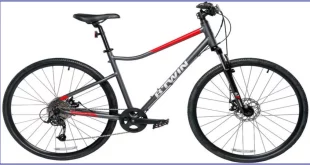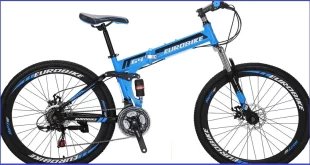Yes, a gravel bike can be used as a commuter bike due to its versatility and ability to handle various terrains and road conditions. With its durable frame, wider tires, and stable geometry, a gravel bike provides a comfortable and efficient ride for daily commuting needs.
Additionally, it offers the flexibility to explore off-road paths during leisure rides. Whether riding on pavement or rough gravel roads, a gravel bike is an excellent choice for commuters seeking a reliable and adaptable option.
Understanding The Role Of A Gravel Bike In Urban Transportation
Gravel bikes have gained immense popularity among cycling enthusiasts in recent years, primarily known for their effectiveness on unpaved terrains. But can you use a gravel bike as a commuter bike, tackling the urban landscape with ease? Let’s delve into the world of gravel bikes and understand their role in urban transportation.
What Is A Gravel Bike And Its Primary Purpose?
A gravel bike is a versatile bicycle designed to handle a variety of terrains, including gravel, dirt, and pavement.
It typically features larger tires, a more relaxed geometry, and specific frame design to offer comfort and stability.
The primary purpose of a gravel bike is to provide riders with the freedom to explore both paved and unpaved routes on a single bike.
Exploring The Versatility Of Gravel Bikes
A gravel bike is not limited to off-road adventures. It can be an excellent choice for commuting in urban areas due to its versatility and adaptability.
- Comfortable riding position: Gravel bikes are designed for long-distance comfort. They offer a more relaxed riding position, enabling riders to maintain an upright posture, reducing strain on the back and neck during commutes.
- Handling rough surfaces: Urban roads can sometimes be riddled with potholes and uneven surfaces. Gravel bikes excel in handling such conditions, providing a stable and smooth ride due to their wider tires and shock-absorbing capabilities.
- All-weather performance: Gravel bikes often come with mounts to attach fenders and racks, allowing riders to equip them for all-weather commuting. Whether it’s rain or shine, you can rely on a gravel bike to get you to your destination.
- Versatile tire options: Gravel bikes have clearance for wider tires, providing the flexibility to choose tires suitable for urban commuting. Opting for slick or semi-slick tires can increase efficiency on paved surfaces, while still maintaining off-road capabilities.
Can You Use Gravel Bike As A Commuter Bike?
Absolutely! Gravel bikes can serve as reliable commuter bikes, offering a multitude of advantages for urban transportation.
- Efficiency on multiple surfaces: A gravel bike’s ability to handle diverse terrains means it can effortlessly glide through paved roads, bike lanes, and even shortcuts like gravel paths or trails.
- Speed and agility: Despite its robust design, a gravel bike can still provide an agile and speedy ride, ensuring you make it to work or appointments in a timely manner.
- Storage options: Many gravel bikes feature mounting points for racks and panniers, allowing you to carry your work essentials or groceries effortlessly. Additionally, some models come with integrated frame bags or handlebar bags, providing additional storage capacity.
- Cost-effective solution: Opting for a gravel bike as a commuter bike eliminates the need for owning multiple bicycles for different purposes. This cost-effective approach can also save space in your living area.
Gravel bikes offer an exciting alternative for urban commuters seeking a reliable and versatile mode of transportation. So grab your helmet, hop on your gravel bike, and explore the city streets with confidence and convenience.
Assessing The Suitability Of Gravel Bikes For Urban Commuting
When it comes to choosing a bike for commuting in urban areas, there are many options available. One such option that has gained popularity in recent years is the gravel bike. Gravel bikes are typically designed for off-road adventures, but can they also be used as a reliable option for daily urban commuting?
Let’s assess the suitability of gravel bikes for this purpose and explore the factors that need to be considered.
Factors To Consider When Choosing A Commuter Bike:
- Comfort and ergonomics: Commuting often involves spending significant time on a bike, so it’s important to prioritize comfort. Look for a bike with a comfortable seating position and ergonomic features that support your posture.
- Tire width and tread: The right tires can make a big difference in your commuting experience. Opt for wider tires that provide stability and shock absorption on uneven city surfaces. Tread patterns that offer grip and traction are also desirable.
- Gearing options: Commuting can involve varying terrain and inclines, so having a wide range of gears is beneficial. Consider bikes with multiple gear options that allow you to adjust the resistance according to your riding conditions.
Examining The Characteristics Of A Gravel Bike:
- Frame design and geometry: Gravel bikes typically feature a more relaxed frame geometry compared to traditional road bikes. This design provides a comfortable riding position and stability, making them suitable for longer rides.
- Component compatibility: Gravel bikes are designed to accommodate a variety of components, making them versatile for different riding styles. The ability to customize your bike’s components adds value and ensures a good fit for commuting needs.
While gravel bikes are primarily intended for off-road riding, they can certainly be used as capable commuter bikes. With their comfort-focused design, wider tires, and versatile components, gravel bikes offer a viable option for urban commuting. Considering the factors mentioned above will help you choose the right gravel bike that meets your specific commuting requirements.
So why not consider the adventure-ready gravel bike as your trusty companion on your daily commute?
Benefits Of Using A Gravel Bike For Commuting
Are you tired of navigating through bumper-to-bumper traffic in your daily commute? Have you considered using a gravel bike instead? Many cyclists are discovering the benefits of using a gravel bike as a commuter bike, and it’s not hard to see why.
We will explore the advantages of using a gravel bike for commuting, from enhancing maneuverability in urban environments to overcoming varied terrain challenges. Let’s dive in!
Enhancing Maneuverability In Urban Environments
- Gravel bikes are designed with agile handling and nimble maneuverability in mind, making them ideal for navigating tight city streets and congested urban areas.
- The lightweight frame and responsive geometry of a gravel bike allow riders to easily maneuver through traffic, making it easier to navigate busy intersections and tight turns.
- The compact design of a gravel bike ensures that it can easily fit into narrow bike lanes, allowing you to bypass stalled traffic and arrive at your destination faster.
Nimble Handling & Quick Acceleration
- Gravel bikes are known for their nimble handling, which enables riders to quickly change direction and avoid obstacles in the urban jungle.
- The responsiveness of a gravel bike allows for quick acceleration, making it easier to keep up with traffic and stay ahead of the pack.
- With its lightweight build and sturdy construction, a gravel bike offers a perfect balance between speed and stability, ensuring a smooth and efficient commute.
Efficient Navigation Through Traffic
- The versatility of a gravel bike allows for efficient navigation through traffic, whether on paved roads or gravel paths.
- The wider tires of a gravel bike provide increased stability, allowing you to confidently weave through traffic without the fear of losing control.
- Gravel bikes often come equipped with disc brakes, which offer reliable stopping power and enhanced safety in stop-and-go traffic situations.
Overcoming Varied Terrain Challenges
- A gravel bike is designed to handle a variety of terrain, making it a perfect choice for urban commuting where the road conditions can be unpredictable.
- From potholes to uneven surfaces, a gravel bike’s wider tires and increased clearance provide a smoother ride, minimizing the impact of rough urban roads.
- With a gravel bike, you can confidently tackle gravel paths, cobblestones, and even occasional off-road sections, allowing for a more adventurous commute.
Potholes And Uneven Surfaces
- Potholes and uneven surfaces are common obstacles in urban areas, but a gravel bike can handle them with ease.
- The wider tires of a gravel bike provide more cushioning and shock absorption, allowing you to ride comfortably over rough surfaces without compromising your speed or stability.
- Gravel bikes often feature wider tire clearance, which means you can opt for larger tires with increased volume, further improving the bike’s ability to glide over potholes and uneven terrain.
Curbs And Obstacles
- Gravel bikes are built with durability in mind, allowing riders to confidently tackle curbs and other urban obstacles.
- The sturdy construction of a gravel bike, combined with its agile handling, makes it easier to maneuver up curbs and navigate around obstacles like parked cars or debris on the road.
- Gravel bikes often have robust wheelsets and components that can withstand the impact of urban riding, ensuring a reliable and efficient commute.
By using a gravel bike as your commuter bike, you can enjoy enhanced maneuverability, nimble handling, and efficient navigation through traffic. Not to mention, a gravel bike’s ability to overcome varied terrain challenges, potholes, uneven surfaces, curbs, and obstacles makes it an excellent choice for urban commuting.
So, why not give it a try and experience a whole new level of commuting freedom?
Addressing Potential Drawbacks Of Utilizing A Gravel Bike For Commuting
Gravel bikes have gained immense popularity in recent years, thanks to their versatility and ability to handle various types of terrain. While they excel on gravel roads and off-road trails, many cycling enthusiasts wonder if these bikes can also serve as reliable commuter bikes.
In this section, we will address some potential drawbacks of using a gravel bike for commuting, focusing on key factors such as speed and efficiency, aerodynamic considerations, weight and rolling resistance, and the overall emphasis on comfort and reliability rather than speed.
Limitations In Speed And Efficiency Compared To Road Bikes:
- Gravel bikes are designed to handle rough roads and uneven surfaces, which may result in slightly slower speeds compared to dedicated road bikes.
- The wider tires and more relaxed geometry of gravel bikes offer better stability and control but may compromise the aerodynamic efficiency, leading to slower overall speeds.
- The gear ratios on gravel bikes are optimized for climbing and off-road capabilities, which may not provide the same level of efficiency when commuting on flat paved surfaces.
Aerodynamic Considerations:
- Unlike road bikes that prioritize aerodynamics for optimal speed, gravel bikes are not specifically designed with aerodynamic efficiency in mind.
- The wider tires and more upright riding position of gravel bikes create more wind resistance, which can negatively impact speed and efficiency, especially during headwinds.
Weight And Rolling Resistance:
- Gravel bikes typically have slightly heavier frames and components to withstand rough terrains, which can make them less efficient when it comes to accelerating and maintaining higher speeds.
- The wider and more aggressive tread pattern on gravel bike tires may result in increased rolling resistance, requiring more pedaling effort, especially on smoother paved surfaces.
Less Emphasis On Speed, More On Comfort And Reliability:
- Gravel bikes are known for their ability to provide a comfortable and stable riding experience, thanks to features like wider tires, relaxed geometry, and additional attachment points for accessories.
- The focus on comfort and reliability rather than pure speed makes gravel bikes ideal for longer commutes and unpredictable road conditions, where comfort and durability are paramount.
Balancing Commuting Needs With Versatility:
- While gravel bikes may have some limitations for commuting in terms of speed and aerodynamic efficiency, they offer unmatched versatility that allows riders to explore different routes and terrain options beyond pavement.
- By carefully selecting the right tires, accessories, and components, riders can strike a balance between commuting needs and the desire to extend their cycling adventures beyond the city streets.
While gravel bikes may not match the speed and efficiency of dedicated road bikes for commuting, they offer a range of advantages such as comfort, stability, and versatility. By understanding and addressing the potential limitations mentioned above, you can make an informed decision about utilizing a gravel bike as your daily commuter, weighing the trade-offs between speed and the unique benefits gravel bikes bring to the table.
Practical Tips For Successfully Using A Gravel Bike As A Commuter Bike
Are you considering using a gravel bike as your commuter bike? It’s a great choice that offers versatility and the ability to handle various terrains. However, there are a few important factors to consider to ensure a smooth and efficient commuting experience.
Here are some practical tips to help you customize your gravel bike setup, choose appropriate tires, and accessories, as well as navigate traffic safely.
Customizing Your Gravel Bike Setup For Commuting:
- Adjust the bike fit: Make sure your bike is properly fitted to your body to maximize comfort and efficiency during your commute.
- Choose an appropriate saddle: Opt for a saddle that suits your riding style and provides ample support for longer rides.
- Install ergonomic handlebars: Consider upgrading to handlebars that offer multiple grip positions, reducing strain on your wrists and hands.
- Add a bike computer: Install a bike computer to track your speed, distance, and other key metrics, making it easier to gauge your performance.
Choosing Appropriate Tires And Tire Pressure:
- Consider commuter tires: Switch to commuter-oriented tires, which have a smoother tread and lower rolling resistance for better efficiency on pavement.
- Find the right tire pressure: Experiment with tire pressures to find the sweet spot that balances comfort, traction, and speed on your specific commuting routes.
Adding Fenders, Racks, And Lights:
- Install fenders: Keep yourself and your bike dry during rainy commutes by adding fenders to prevent water and mud splashes.
- Install a rear rack: Attach a rear rack to carry your daily essentials, such as a briefcase or groceries, making your commute more practical and convenient.
- Add lights: Ensure your safety and visibility, especially during darker hours, by installing front and rear lights on your gravel bike.
Safety Precautions And Considerations:
- Wear a helmet: Protect your head by always wearing a helmet, regardless of the distance of your commute.
- Check your brakes: Regularly inspect and maintain your brakes to guarantee they are in optimal condition for quick and effective stopping.
- Be mindful of traffic rules: Observe traffic laws, including stopping at traffic lights, signaling turns, and yielding the right of way to pedestrians.
Wearing Proper Protective Gear:
- Invest in reflective gear: Enhance your visibility on the road by wearing reflective clothing or accessories, especially during low-light conditions.
- Consider padded gloves: Protect your hands and improve grip by using padded gloves, which can also help reduce hand fatigue during longer commutes.
- Wear high-visibility clothing: Opt for brightly colored clothing to ensure that fellow road users can easily spot you, even in busy traffic.
Navigating Traffic And Road Sharing Etiquette:
- Plan your route: Map out your commute in advance, considering the most bike-friendly roads or paths available.
- Follow traffic signals: Obey traffic lights and signs, signaling your intentions to other road users for safe and predictable navigation.
- Practice defensive cycling: Anticipate the actions of motorists, pedestrians, and other cyclists to avoid potential accidents, and always be aware of your surroundings.
Successfully using a gravel bike as a commuter bike involves customizing your setup, choosing appropriate tires, and adding essential accessories like fenders, racks, and lights. Safety precautions, including wearing protective gear and practicing good road etiquette, are vital for a safe and enjoyable commuting experience.
By following these practical tips, you can make your gravel bike an ideal companion for your daily commute.
Case Studies: Real-Life Commuters Using Gravel Bikes
When it comes to choosing a bike for your daily commute, the options can seem endless. One emerging trend that has caught the attention of urban commuters is the use of gravel bikes. Originally designed for tackling off-road terrain, gravel bikes are gaining popularity as versatile and reliable urban commuting machines.
In this section, we’ll hear from experienced urban commuters who have made the switch to gravel bikes, and gain insights into their personal experiences. Let’s delve into some real-life case studies and explore the benefits and challenges they encountered along the way.
Hear From Experienced Urban Commuters Who Utilize Gravel Bikes:
- Jane, a seasoned cyclist, has embraced her gravel bike as a reliable mode of transportation. She loves its ruggedness and versatility, allowing her to navigate through various terrains effortlessly.
- David, an adventurous urban commuter, finds his gravel bike perfect for exploring alternative routes and cutting through traffic. The bike’s wider tires provide stability and control on pothole-ridden city streets.
- Sarah, a health-conscious commuter, appreciates the efficiency of her gravel bike. The lightweight frame and geometry make it a joy to ride, ensuring she arrives at work feeling energized and ready for the day.
Their Personal Experiences And Insights:
- The ability to handle different terrains, from pavement to gravel roads, offers a sense of freedom and flexibility to urban commuters.
- Gravel bikes’ geometry and frame design prioritize comfort, making long commutes more enjoyable, even for those with back or joint issues.
- Commuters find that gravel bikes’ wider tires improve stability and traction, increasing confidence when riding in wet or slippery conditions.
- The bike’s durability and ability to carry extra load, such as panniers or bike bags, make it convenient for those who need to transport work essentials or groceries.
Benefits And Challenges They Encountered:
Benefits:
- Versatility: Gravel bikes adapt well to various road conditions, giving urban commuters the freedom to explore different routes.
- Comfortable ride: The bike’s design prioritizes comfort, making long commutes less tiring on the body.
- Stability and control: Wider tires enhance stability, providing confidence to riders even in challenging urban environments.
- Durability: Gravel bikes are built to withstand the rigors of daily commuting, ensuring longevity and reliability.
Challenges:
- Speed: Gravel bikes are not as fast as road bikes, which may be a consideration for those with time-sensitive commutes.
- Maintenance: The off-road capabilities of gravel bikes mean they may require more frequent maintenance compared to traditional urban bikes.
- Cost: While gravel bikes come with a range of price points, they can be more expensive than other commuting options.
These case studies shed light on the experiences and perspectives of real-life urban commuters who have chosen to embrace gravel bikes for their daily journeys. While there are benefits and challenges to consider, it is clear that gravel bikes offer a unique and exciting commuting experience for those seeking versatility, comfort, and the joy of exploring their urban surroundings.
Frequently Asked Questions Of Can You Use Gravel Bike As A Commuter Bike?
Can A Gravel Bike Be Used As A Commuter Bike?
Yes, a gravel bike can be used as a commuter bike. The versatility of a gravel bike allows it to handle various terrains, including pavement. With the right tires and accessories, it can be a reliable and comfortable option for commuting.
Are Gravel Bikes Good For Commuting?
Gravel bikes can be a great choice for commuting. Their wider tires provide better stability and comfort on different surfaces. The more relaxed geometry also offers a comfortable riding position for longer commutes. Additionally, gravel bikes generally have mounts for pannier racks, making it easier to carry items.
Can You Ride A Gravel Bike On The Road?
Yes, you can ride a gravel bike on the road. While gravel bikes are designed for off-road adventures, their versatility allows them to perform well on paved surfaces too. However, it’s important to choose the right tires and adjust the tire pressure for optimal performance on the road.
What Are The Advantages Of Using A Gravel Bike For Commuting?
Using a gravel bike for commuting has several advantages. These bikes are built to handle different terrains, providing a smoother ride on uneven roads. The wider tires increase stability and comfort, while the ability to add racks and fenders allows for easy carriage of items and protection from the elements.
How Does A Gravel Bike Compare To A Road Bike For Commuting?
While road bikes are built for speed on smooth surfaces, gravel bikes are more versatile and better equipped to handle diverse road conditions. Gravel bikes have wider tires for improved stability, mounts for carrying accessories, and a more upright riding position for increased comfort during commutes.
Conclusion
To sum up, gravel bikes can indeed be used as commuter bikes due to their versatility and durability. They offer a comfortable riding position and the ability to handle various road conditions, making them suitable for daily commuting. The wider tires of gravel bikes provide better stability and traction, allowing riders to navigate through potholes, gravel, and uneven surfaces without much hassle.
Moreover, the addition of fender and rack mounts enable you to carry your belongings during your commuting journey. With the growing popularity of gravel biking, more and more cyclists are embracing these bikes as their go-to option for their daily commutes.
So, if you are looking for a bike that can handle both smooth and rough terrains while offering superb comfort and versatility, a gravel bike might just be the answer. Ride your gravel bike to work and discover the joy and freedom it brings to your everyday commuting experience.
 CommutingLife Explore The World On Two Wheels
CommutingLife Explore The World On Two Wheels





